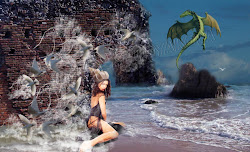"Ciudad de recuerdo" 40x30 cm
"Segovia en otro mundo" 73x35 cm
"Primavera en Segovia" 75x35cm
Segovia is Spain and Castile at its best - twisting alleyways, the highest concentration of Romanesque churches in all of Europe.
On the north-west extreme of the wall is the famous Alcázar castle, source of inspiration to Walt Disney, and where Queen Isabel promised Columbus the financial backing he needed to discover America.
On the south-east extreme is the world renowned Roman Aqueduct, the largest and best preserved of its kind anywhere, which served as the mintmark on all coins struck in the city from 1455 to 1864. The tallest building in Segovia is still the 16th-century Cathedral, a prominent landmark as one approaches from any direction.
The city's 2,000 year old Roman aquaduct cuts right through the center of town. Its symbol has served as the mintmark on all coins struck in Segovia for over 400 years.
 ¡Sigue violinista divina!
¡Sigue violinista divina! 



















